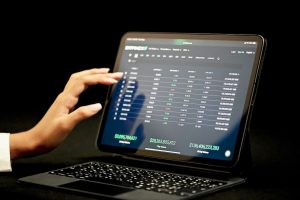Forex trading is a lucrative investment opportunity that involves buying and selling currencies based on market conditions. One of the most crucial aspects of forex trading is determining the trend of the market. A trend can be defined as the general direction of the market, which can be either upward, downward, or sideways. Understanding market trends is vital for successful forex trading as it helps traders to make informed decisions about buying or selling currencies. In this article, we will explore the various methods of determining trends in forex trading.
Method 1: Using Moving Averages
The moving average is a popular tool used in forex trading to determine trends. It is a technical indicator that calculates the average price of a currency pair over a specific period. The moving average is plotted on a chart, and traders can use it to identify the direction of the trend. The most commonly used moving averages are the 50-day and 200-day moving averages. When the 50-day moving average crosses above the 200-day moving average, it indicates an upward trend, while a crossover below the 200-day moving average indicates a downward trend.
Method 2: Using Trendlines
Another effective way of determining trends in forex trading is by using trendlines. Trendlines are lines drawn on a chart that connect the highs or lows of the price movement. They help traders to identify the direction of the trend and make informed decisions about buying or selling currencies. An upward trendline is drawn by connecting the lows of the price movement, while a downward trendline is drawn by connecting the highs of the price movement.
Method 3: Using Relative Strength Index (RSI)
The relative strength index (RSI) is a technical indicator that measures the strength of a currency pair’s price movement. It ranges from 0 to 100 and is used to identify overbought or oversold conditions in the market. When the RSI is above 70, it indicates an overbought condition, which means that the currency pair is likely to experience a downward trend. On the other hand, when the RSI is below 30, it indicates an oversold condition, which means that the currency pair is likely to experience an upward trend.
Method 4: Using Moving Average Convergence Divergence (MACD)
The moving average convergence divergence (MACD) is a popular technical indicator used in forex trading to determine trends. It is calculated by subtracting the 26-day exponential moving average (EMA) from the 12-day EMA. The MACD line is then plotted on the chart, along with a signal line, which is a 9-day EMA of the MACD line. When the MACD line crosses above the signal line, it indicates an upward trend, while a crossover below the signal line indicates a downward trend.
Method 5: Using Price Action Analysis
Price action analysis is a method of determining trends in forex trading by analyzing the price movement of a currency pair. It involves studying patterns, trends, and support and resistance levels on a chart to identify the direction of the trend. Traders can use price action analysis to make informed decisions about buying or selling currencies based on the market conditions.
Conclusion
Determining trends in forex trading is crucial for successful trading. Traders can use various methods to identify trends, including moving averages, trendlines, relative strength index (RSI), moving average convergence divergence (MACD), and price action analysis. It is essential to understand the different methods and choose the one that best suits your trading style and preferences. By mastering the art of trend analysis, traders can increase their chances of making profitable trades in the forex market.






